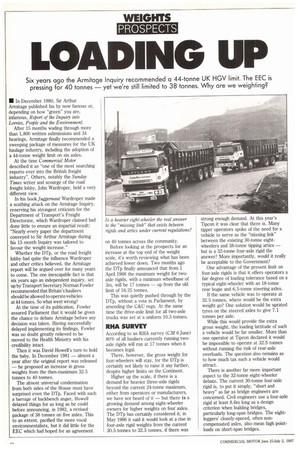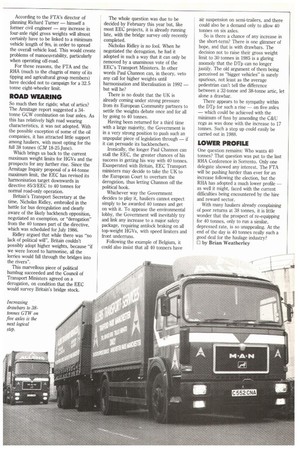LOADING UP
Page 44

Page 45

If you've noticed an error in this article please click here to report it so we can fix it.
Six years ago the Armitage Inquiry recommended a 44-tonne UK HGV limit. The EEC is pressing for 40 tonnes — yet we're still limited to 38 tonnes. Why are we weighting?
• In December 1980, Sir Arthur Armitage published his by now famous or, depending on how "green" you are, infamous, Report of the Inquiry into Lorries, People and the Environment.
After 15 months wading through more than 1,800 written submissions and 34 hearings, Armitage finally recommended a sweeping package of measures for the UK haulage industry, including the adoption of a 44-tonne weight limit on six axles.
At the time Commercial Motor described it as "one of the most searching reports ever into the British freight industry". Others, notably the Sunday Times writer and scourge of the road freight lobby, John Wardroper, held a very different view.
In his book Juggernaut Wardroper made a scathing attack on the Armitage Inquiry, reserving his strongest criticism for the Department of Transport's Freight Directorate, which Wardroper claimed had done little to ensure an impartial result: "Nearly every paper the department conveyed to Sir Arthur Armitage during his 15 month Inquiry was tailored to favour the weight increase."
Whether the Dip, or the road freight lobby had quite the influence Wardroper and other critics believed, the Armitage report will be argued over for many years to come. The one inescapable fact is that six years ago an independent inquiry, set up by Transport Secretary Norman Fowler recommended that Britain's hauliers should be allowed to operate-vehicles at 44 tonnes. So what went wrong?
At the time of its publication, Fowler assured Parliament that it would be given the chance to debate Armitage before any decision was taken. Having successfully delayed implementing its findings, Fowler was no doubt greatly relieved to be moved to the Health Ministry with his credibility intact.
Then it was David Howell's turn to hold the baby. In December 1981 — almost a year after the original report was released — he proposed an increase in gross weights from the then-maximum 32.5 tonnes to 40 tonnes.
The almost universal condemnation from both sides of the House must have surprised even the DTp. Faced with such a barrage of backbench anger, Howell delayed things for as long as he could before announcing, in 1982, a revised package of 38 tonnes on five axles. This to an extent, pacified the more vocal environmentalists, but it did little for the EEC which had hoped for an agreement on 40 tonnes across the community.
Before looking at the prospects for an increase at the top end of the weight scale, it's worth reviewing what has been achieved lower down. Two months ago the DTp finally announced that from 1 April 1988 the maximum weight for twoaxle rigids, with a minimum wheelbase of 3m, will be 17 tonnes — up from the old limit of 16.25 tonnes.
This was quietly pushed through by the DTp, without a vote in Parliament, by amending the C&U regs. At the same time the drive-axle limit for all two-axle trucks was set at a uniform 10.5 tonnes.
RHA SURVEY
According to an RI-IA survey (CM 6 June) 80% of all hauliers currently running twoaxle rigids will run at 17 tonnes when it becomes legal.
There, however, the gross weight for four-wheelers will stay, for the Dip is certainly not likely to raise it any further, despite higher limits on the Continent.
Higher up the scale, if there is a demand for heavier three-axle rigids beyond the current 24-tonne maximum, either from operators or manufacturers, we have not heard of it — but there is a growing demand among eight-wheeler owners for higher weights on four axles. The DTp has certainly considered it; in May 1986 it said it would look at a rise in four-axle rigid weights from the current 30.5 tonnes to 32.5 tonnes, if there was strong enough demand. At this year's Tipcon it was clear that there is. Many tipper operators spoke of the need for a vehicle to serve as the "missing link" between the existing 30-tonne eightwheelers and 38-tonne tipping artics — but is a 32-tonne four-axle rigid the answer? More importantly, would it really be acceptable to the Government?
One advantage of the present limit on four-axle rigids is that it offers operators a fair degree of loading tolerance based on a typical eight-wheeler with an 18-tonne rear bogie and 6.5-tonne steering axles.
If the same vehicle was to operate at 32.5 tonnes, where would be the extra weight go? One solution would be uprated tyres on the steered axles to give 7.1 tonnes per axle.
While this would provide the extra gross weight, the loading !attitude of such a vehicle would be far smaller. More than one operator at Tipcon declared it would be impossible to operate at 32.5 tonnes without running the risk of rear-axle overloads. The question also remains as to how much tax such a vehicle would attract.
There is another far more important aspect to the 32-tonne eight-wheeler debate. The current 30-tonne four-axle rigid is, to put it simply, "short and heavy" as far as bridge engineers are concerned. Civil engineers use a four-axle rigid at least 8.6m long as a design criterion when building bridges, particularly long-span bridges. The eightleggers' closely-spaced, often noncompensated axles, also mean high pointloads on short-span bridges. According to the ETA's director of planning Richard Turner — himself a former civil engineer — any increase in four-axle rigid gross weights will almost certainly have to be linked to a minimum vehicle length of 9m, in order to spread the overall vehicle load. This would create problems of manoeuvrability, particularly when operating off-road.
For these reasons, the ETA and the RHA (much to the chagrin of many of its tipping and agricultural group members) have decided not to campaign for a 32.5 tonne eight-wheeler limit.
ROAD WEARING
So much then for rigids; what of artics? The Armitage report suggested a 34tonne GCW combination on four axles. As this has relatively high road wearing characteristics, it was not adopted. With the possible exception of some of the oil companies, it has attracted little support among hauliers, with most opting for the full 38 tonnes (CM 18-25 June).
Which brings us back to the current maximum weight limits for HGVs and the prospects for any further rise. Since the Armitage Inquiry proposal of a 44-tonne maximum limit, the EEC has revised its harmonisation target downwards in directive 85/3/EEC to 40 tonnes for normal road-only operation.
Britain's Transport Secretary at the time, Nicholas Ridley, embroiled in the battle for bus deregulation and clearly aware of the likely backbench opposition, negotiated an exemption, or "derogation" from the 40 tonnes part of the directive, which was scheduled for July 1986.
Ridley argued that while there was "no lack of political will", Britain couldn't possibly adopt higher weights, because "if we were forced to harmonise, all the lorries would fall through the bridges into the rivers".
This marvellous piece of political humbug succeeded and the Council of Transport Ministers agreed on a derogation, on condition that the EEC would survey Britain's bridge stock. The whole question was due to be decided by February this year but, like most EEC projects, it is already running late, with the bridge survey only recently completed.
Nicholas Ridley is no fool. When he negotiated the derogation, he had it adopted in such a way that it can only be removed by a unaminous vote of the EEC's Transport Ministers. In other words Paul Channon can, in theory, veto any call for higher weights until harmonisation and liberalisation in 1992 — but will he?
There is no doubt that the UK is already coming under strong pressure from its European Community partners to settle the weights debate once and for all by going to 40 tonnes.
Having been returned for a third time with a large majority, the Government is in a very strong position to push such an unpopular piece of legislation through — if it can persuade its backbenchers.
Ironically, the longer Paul Channon can stall the EEC, the greater chances of his success in getting his way with 40 tonnes. Exasperated with Britain, EEC Transport ministers may decide to take the UK to the European Court to overturn the derogation, thus letting Channon off the political hook.
Whichever way the Government decides to play it, hauliers cannot expect simply to be awarded 40 tonnes and get on with it. To appease the environmental lobby, the Government will inevitably try and link any increase to a major safety package, requiring antilock braking on all top-weight HGVs, with speed limiters and front underruns.
Following the example of Belgium, it could also insist that all 40 tonners have air suspension on semi-trailers, and there could also be a demand only to allow 40 tonnes on six axles.
So is there a chance of any increase in the short-term? There is one glimmer of hope, and that is with drawbars. The decision not to raise their gross weight limit to 30 tonnes in 1985 is a glaring anomoly that the DTp can no longer justify. The old argument of them being perceived as "bigger vehicles" is surely spurious, not least as the average pedestrian can't tell the difference between a 32-tonne and 38-tonne artic, let alone a drawbar.
There appears to be sympathy within the DTp for such a rise — on five axles — which could be achieved with the minimum of fuss by amending the C&U regs as was done with the increase to 17 tonnes. Such a step up could easily be carried out in 1988.
LOWER PROFILE
One question remains: Who wants 40 tonnes? That question was put to the last RHA Conference in Sorrento. Only one delegate showed any interest. The FTA will be pushing harder than ever for an increase following the election, but the RHA has adopted a much lower profile — as well it might, faced with the current difficulties being encountered by the hire and reward sector.
With many hauliers already complaining of poor returns at 38 tonnes, it is little wonder that the prospect of re-equipping for 40 tonnes, only to run a similar, depressed rate, is so unappealing. At the end of the day is 40 tonnes really such a good deal for the haulage industry? 0 by Brian Weatherley




















































































































































